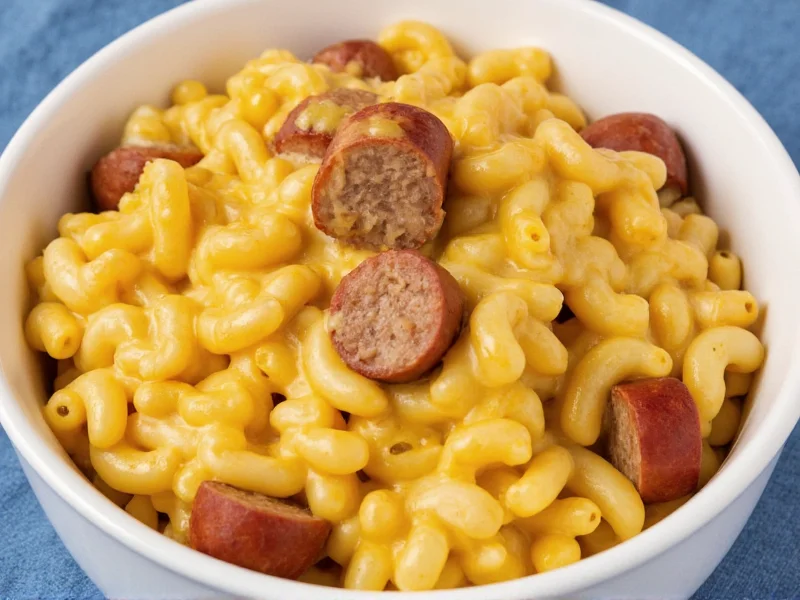The perfect sausage and mac and cheese combines creamy, cheesy pasta with savory sausage for a hearty comfort meal. This classic American dish typically features elbow macaroni, a rich cheese sauce (often cheddar-based), and cooked sausage (bratwurst, kielbasa, or smoked sausage work best). The sausage adds protein and depth of flavor while complementing the creamy texture of traditional macaroni and cheese.
Why Sausage and Mac and Cheese Works So Well
Sausage and mac and cheese represents the ultimate comfort food fusion that has gained popularity across American households. The combination works because the saltiness and smokiness of quality sausage perfectly balances the rich, creamy cheese sauce. When properly prepared, the sausage adds protein and texture contrast without overwhelming the delicate cheese flavors.
This dish has evolved from basic cafeteria fare to a sophisticated comfort meal that appears on menus at gastropubs and family restaurants nationwide. The versatility of sausage and mac and cheese allows for endless variations while maintaining its essential comforting qualities.
Choosing the Right Sausage for Your Mac and Cheese
Selecting the appropriate sausage makes a significant difference in your final dish. Different sausage varieties bring unique flavor profiles that can transform your mac and cheese from ordinary to extraordinary.
| Sausage Type | Flavor Profile | Best For | Cooking Tip |
|---|---|---|---|
| Bratwurst | Mild, slightly sweet, herbal | Family-friendly meals | Parboil before browning for even cooking |
| Kielbasa | Smoky, garlicky, robust | Hearty winter meals | Slice thick to maintain texture in sauce |
| Andouille | Spicy, smoky, complex | Cajun-inspired versions | Use sparingly if sensitive to heat |
| Breakfast Sausage | Peppery, sage-forward | Brunch adaptations | Remove excess grease before adding to pasta |
Creating the Perfect Sausage Mac and Cheese
Essential Ingredients Checklist
- Elbow macaroni (8 ounces for 4 servings)
- Quality sausage (1 pound, preferably with some fat content)
- Sharp cheddar cheese (8 ounces, freshly grated)
- Gruyère or fontina (4 ounces for complexity)
- Butter (3 tablespoons)
- All-purpose flour (3 tablespoons)
- Milk (2 cups, whole milk recommended)
- Dijon mustard (1 teaspoon)
- Nutmeg (pinch)
- Panko breadcrumbs (optional topping)
Step-by-Step Preparation Guide
- Cook pasta al dente according to package directions, reserving 1 cup pasta water before draining
- Brown sausage in large skillet over medium heat, breaking into bite-sized pieces
- Remove cooked sausage, leaving 1-2 tablespoons of fat in skillet
- Create roux by melting butter in sausage fat, then whisking in flour for 2 minutes
- Gradually add milk while whisking constantly until smooth and thickened
- Reduce heat to low and stir in cheeses until fully melted and smooth
- Add mustard, nutmeg, and salt to taste (be cautious as sausage adds saltiness)
- Fold in cooked pasta and sausage, adding reserved pasta water as needed for creaminess
- Transfer to baking dish, top with breadcrumbs if desired, and bake at 375°F for 20-25 minutes
Pro Tips for Exceptional Sausage Mac and Cheese
Achieving restaurant-quality sausage mac and cheese at home requires attention to specific details that many home cooks overlook. These professional kitchen insights can elevate your dish from good to exceptional.
Cheese selection matters more than you think. Pre-shredded cheese contains anti-caking agents that can make your sauce grainy. Always grate your cheese from blocks for the smoothest texture. A combination of cheeses creates more complex flavor than single-variety cheese sauces.
Don't skip the pasta water. The starchy water helps emulsify the cheese sauce and creates a silky texture that properly coats each noodle. Add it gradually until you achieve your desired consistency.
Temperature control is crucial. Never boil your cheese sauce after adding the cheese, as high heat causes the proteins to seize and the fats to separate. Maintain a gentle simmer for perfect creaminess.
Popular Variations to Try
Once you've mastered the basic sausage and mac and cheese recipe, experiment with these popular variations that cater to different tastes and dietary needs:
- Smoked Gouda Upgrade: Replace half the cheddar with smoked gouda for deeper smoky notes that complement the sausage
- Vegetable-Enhanced: Add roasted broccoli or caramelized onions for added nutrition without compromising flavor
- Spicy Cajun Style: Use andouille sausage and add cayenne pepper, smoked paprika, and a dash of hot sauce
- Gluten-Free Option: Substitute gluten-free pasta and use cornstarch instead of flour for the roux
- Creamier Stovetop Version: Skip baking and serve immediately for ultra-creamy texture
Serving and Storage Recommendations
Serve sausage mac and cheese immediately after baking for best texture. The dish pairs wonderfully with simple green salads, roasted vegetables, or garlic bread. For meal prep enthusiasts, this dish stores exceptionally well in the refrigerator for 3-4 days.
When reheating, add a splash of milk to restore creaminess. For best results, reheat in the oven at 350°F covered with foil for 20 minutes, then uncovered for 5-10 minutes to refresh the topping. Avoid microwaving if possible, as it can make the pasta gummy.











 浙公网安备
33010002000092号
浙公网安备
33010002000092号 浙B2-20120091-4
浙B2-20120091-4